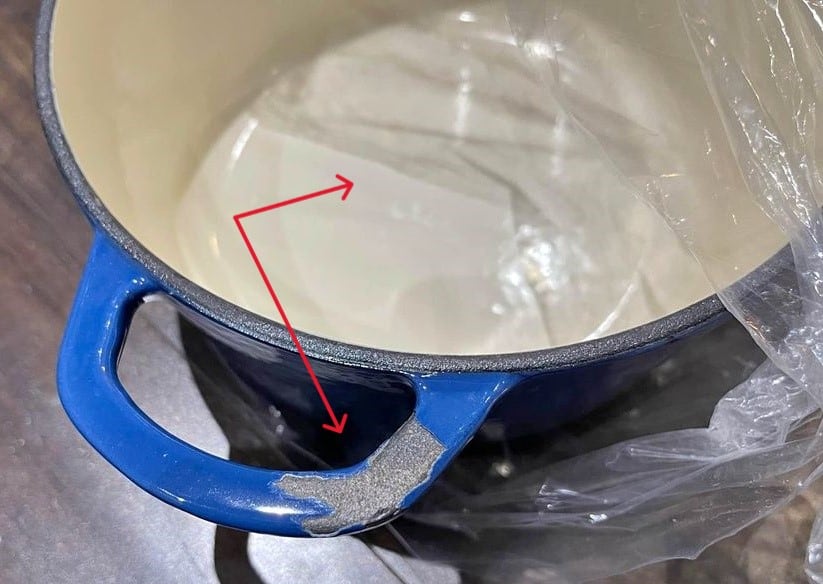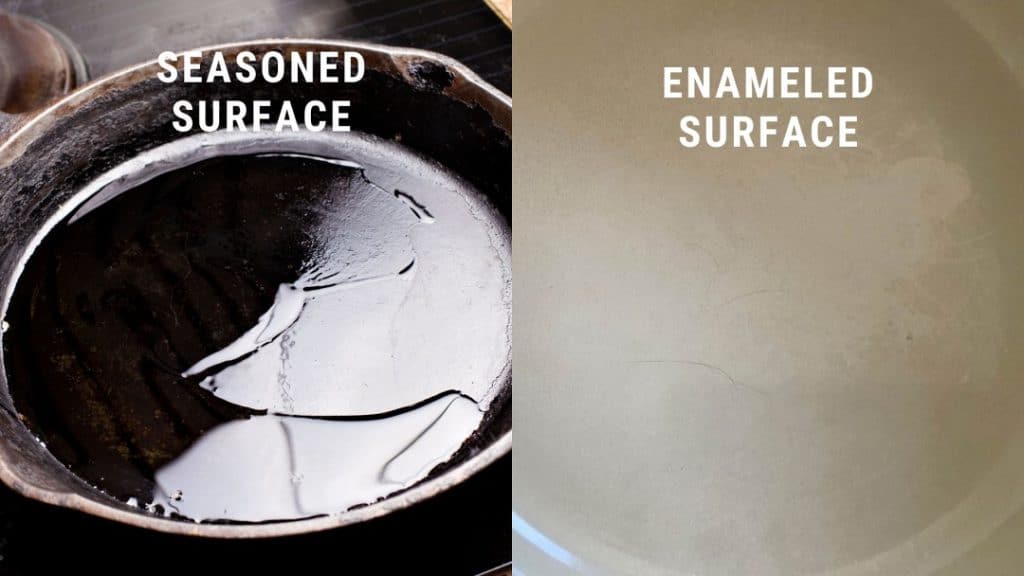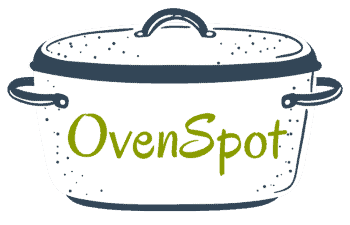Cast Iron vs Enameled Cast Iron Cookware: Which is Better?
Cast iron and enameled cast iron are two types of cookware that can be incredibly daunting to newbies in the culinary world. Heated debates, coupled with the battle for supremacy between these two combatants, leave you feeling a little unsure about what you should look for in this cookware.
A bare or traditional cast iron pan has a seasoned surface, while an enameled cast iron pan has layers of enamel coating its cast iron core. Cast iron is naturally non-stick when its surface is maintained with seasoning, while enameled cast iron requires liberal amounts of oil when cooking to stop food from sticking.
Give and take, these pots are versatile, durable, and perform as well as the others. They are both low maintenance and don’t require much care. Dishwashers should be avoided by both cookware types even though enameled cast iron is not prone to rust. Handwashing for both is recommended.

Some home cooks swear by (a bare) or traditional cast iron skillet as they feel it’s more robust for outdoor cooking, and the food tastes better, while others say enameled pieces are comfortable to cook with, easy to clean, and convenient. So, who is right? Let’s find out which is the better option.
This post may contain affiliate links. Please read our disclaimer.
Cast Iron vs Enameled Cast Iron Comparison Chart

Two of the best Dutch ovens available are the uncoated cast iron Lodge Dutch Oven and the gold standard Le Creuset Dutch Oven (French Oven) coated in porcelain enamel.
Use this comparison table to see the main differences between a raw (or bare) cast iron Dutch oven and an enamel Dutch oven.
| Ceramic | Stainless Steel | |
|---|---|---|
| Construction | Hard anodized aluminum | Aluminum, stainless steel, hard-anodized aluminum |
| Design | Round Dutch ovens and oval Dutch ovens, French ovens, Cocotte, skillets, griddles, Braisers, and bakeware. A wide choice of sizes and shapes in all types of enameled cast iron cookware | Round Dutch ovens and oval Dutch ovens, French ovens, Cocotte, skillets, griddles, Braisers, and bakeware. A large choice of sizes and shapes in all types of enameled cast iron cookware |
| Finish | Dark gray/black gets darker with more use. Bare cast iron has a rougher surface | Exterior shiny in a wide variety of colors, interior light or dark |
| Heat Source | Suitable for all heat sources indoor and outdoor | No open fires, naturally induction ready, ceramic, glass stovetop, gas, electric, oven |
| Temperature | Will withstand temperatures in excess of 500 °F | Temperatures up to 500 °F depending upon the cookware quality and design (knobs and handles should be oven safe) |
| Heat Retention | High | High |
| Performance | Nothing compares to the ability to sear steaks on a well-seasoned cast-iron skillet. If the surface is maintained non-stick properties are excellent | Not non-stick when searing oils or liquid required. Comparing slow cooking, roasting, and baking both perform well |
| Durability | Maintenance will last a long time with care your lifetime and beyond | With care, iron can last a lifetime although the enamel will deteriorate long before the cast iron |
| Clean Up | No dishwasher, no soaking, no soap, scourers & hot water, dry immediately | No dishwasher, warm soapy water, soaking then nylon scourers, dry thoroughly |
| Maintenance | Pre-seasoned cast iron should still be seasoned before first use, bare cast iron needs seasoning regularly | Seasoning the enamel is not required, you can season bare cast iron rims on pots and lids to prevent rusting |
| Iron Release | Yes, less with regular seasoning | No, if the enamel is intact |
| Price | Less expensive | More expensive than regular cast iron |
What Is Regular Cast Iron?
Traditional cast iron cookware is made from melted iron cast as a single metal piece, including the handle. It can withstand and maintain high temperatures making it an excellent choice for the open flame, and is a great option for frying and searing meat. Iron pots are also an ideal choice for braised dishes and long-cooking stews.
Cast-iron cooking utensils are thicker than similar-sized cookware and capable of storing heat longer than other materials. The thermal mass feature in cast-iron heavy-duty pots and pans allows them to retain heat for an extended period and continue cooking food after removing the heat source.
Types of cast-iron cookware include a skillet, a deep fryer, a pre-seasoned Dutch oven, an enameled Dutch oven, a flat-top grill, a waffle iron, a wok, karahi, a crepe maker, and more. Cast iron does best outdoors and makes a classic staple for camping. A large pot that holds up well in the open fire, plus you don’t have to worry about ruining the finish.
However, when it comes to cleaning, the cast iron should be wiped after the cooking process or washed in mild soapy water with a stiff brush and then reapplied with a thin layer of fat or oil.
Related read: what is the best oil for seasoning a cast iron skillet?
What Is Enameled Cast-Iron?
An enameled cast iron piece of cookware features vitreous enamel paint on the surface that prevents rust and eliminates the need for seasoning the metal. It’s also more comfortable when cleaning and can fit in a dishwasher and the microwave. It’s an ideal choice for slow cooking as it helps draw flavors from foods.
Enameled cast-iron cookware offers different pigmentations that make them attractive to the eye. Unlike cast iron, the ability to withstand extreme heat and resist sticking is lost through enameling. If you overheat, drop, or add cold water to a hot pot, chipping of the glazed coating can occur.
Enameled cast iron is mainly used for indoor cooking and offers the best results when cooking on the stovetop. Enameled Dutch ovens, in particular, keep moisture, which makes the food tastier.
Differences Between Cast-Iron and Enameled Cast-Iron
Now that you have understood the two applications of regular cast iron and enameled cookware, we will look at the features that differentiate cookware. Let’s dive in.
1. Design
Seasoned Cast-Iron
A cast-iron skillet or Dutch oven features a classic black or brown color and includes pig iron and scrap steel to give them a rugged look with excellent factory seasoning.
Almost every American home kitchen has one for searing T-bones, frying eggs, and crisp golden cornbread to roast a chicken.
Enameled Cast-Iron
On the other hand, enameled cast-iron cookware has a vibrant, colorful exterior with a glossy finish that makes a design statement in any kitchen.
It’s easy to clean and fits comfortably in a dishwasher, making it an ideal choice for all-purpose cooking and keeping food evenly cooked.
Le Creuset and Staub are market leaders in the manufacture and distribution of quality enameled cast iron cookware. Both offer an extensive range of “A” Grade cookware made from cast iron. Both companies hone their casting and glazing skills and manufacturing in France while distributing to the world.
2. Sizes, Shapes, and Colors

Seasoned Cast-Iron
There are many cast iron pot sizes and shapes of cast iron skillets, fry pans, round Dutch ovens, and grill pans. As well as many cast iron accessories required when using regular cast iron pans, especially outdoors. Unfortunately, the colors are limited to gray, darker gray, and black.
Enameled Cast-Iron
In comparison, there are many more sizes and shapes available in enameled cast iron cookware. Availability is because there are more kitchens throughout the world than campfires.
Colors vary from brand to brand. Luxury enameled cookware manufacturer Le Creuset has the largest range of virtuous enamel colors of any brand – approximately 20, with limited additions being added regularly. The Staub Dutch oven color range sits at 9-10 earthy core colors with a dark enamel interior.
An added advantage of enameled cast iron is matching decor pieces to your kitchen. Brands like Le Creuset offer matching colors throughout their range, including utensils, accessories, and cookware. Serving dishes directly from enamel cast iron at the table is also a clean-up saver.
Le Creuset drops new colors for their cookware collections throughout the year. Check out my up-to-date Le Creuset Color Guide.
3. Reactiveness to Rust
Seasoned Cast-Iron
Cast iron can acquire some rust over time, mostly if the manufacturer’s seasoning is stripped off through chemical, physical, or electric means.
Washing your cast iron in a conventional dishwasher or with soap can strip off the pre-seasoning and lead to rust, quality, and performance issues.
Also, avoid cooking acidic foodstuffs such as tomatoes with your cast-iron cookware as it damages the seasoning. However, you can re-season with a layer of animal fat or vegetable oil.
Seasoning new cast iron before its first use is always beneficial.
Enameled Cast-Iron
99% of an enameled cast iron skillet, pot, or lid doesn’t need to be seasoned as the glazed enamel coating prevents rust.
The exposed cast iron around the top of the pot/skillets and the rim of the lids should be seasoned to prevent rust.

4. Heat Sources
Seasoned Cast-Iron
Raw cast iron can be used on all heat sources: electric stovetops, ceramic, glass, gas, induction, conventional ovens, grills, and open campfires.
The caveat is that great care should be taken when using cast iron with a rough base on all kitchen cooktops and appliances. The exterior of raw cast iron does not benefit from a smooth enamel base.
So if you are cooking with cast iron on a glass top stove and there are sharp spots or a pitted surface of the base, you could scratch the glass stovetop.
Enameled Cast-Iron
Although an enameled pan is safer for kitchen appliances, scratching campfire flame on enameled pans and cookware should be avoided.
5. Performance
Both raw cast iron and enameled cast iron take longer to heat up than other types of cookware. But unlike different types of cookware, the heat retention properties are the same, even after being removed from heat. Once it is heated up, cast iron maintains an even heat, so there will be no hot spots when cooking.
Seasoned Cast-Iron
A well-seasoned traditional cast-iron surface makes it one of the most nonstick cooking surfaces available, even when exposed to extreme heat.
When cooking steak, traditional cast iron top’s extreme heat-absorbing properties make it the way to go. Not only do traditional cast iron skillets provide even heat distribution, but they also help to lock in flavor and juices.
Tip: When frying with a traditional cast iron skillet, heat the pan until it is smoking hot before adding any oil. Then, add your steak and cook for two minutes per side. For rare steak, cook for three minutes per side. Remove from the pan and let rest for five minutes before serving. This method will ensure that your steak is cooked to perfection.
Unfortunately, the pH and acid levels in some foods like lemon and tomato can break down the outer layer of the cast-iron surface. Making it important to maintain the non-stick cooking surface with regular seasoning.
Enameled Cast-Iron
Unfortunately, enamel cast iron is not non-stick. Its surface will require plenty of oil or water when cooking. However, an enameled cast iron pot and pan glass-like non-porous surface will not be ruined by acidic food. If you have a light-colored enamel interior, it will likely discolor over time.
6. Durability
Seasoned Cast-Iron
Cast-iron cookware is heavy and dense. Metal utensils can be used, making them durable and, based on use, can last generations with proper care. Plain cast iron can withstand open flames and higher temperatures, making them a better choice for outdoor use.

Enameled Cast-Iron
On the other hand, enameled cast iron skillets have a short life expectancy, can last 3-5 years, and need special attention to last. They don’t tolerate high heat. Use medium heat, and lower heat prevents food from sticking to the surface.
Glazed enamel coating can chip, crack, or come off with rough usage. Avoid metal utensils that can damage the cast iron’s surface; use wooden or silicone utensils instead.
An enameled Dutch oven is the perfect pot for stewing and slow cooking, but unlike standard cast iron, a light-colored interior will discolor over time.
To minimize this discoloration, avoid cooking with tomatoes, curry, and chili and clean as soon as possible. Avoid cold water on a hot pan. Thermal shock can occur and induce cracking.
However, you can use enameled cast-iron cookware in a microwave and wash it in a dishwasher, although hand washing is recommended. Do not use cold water on a hot pan to avoid thermal shock.
7. Health Effects
Seasoned Cast-Iron
Studies indicate that cast-iron cookware leeches significant amounts of iron in the food depending on its water content, acidity, and how long the food was cooked, among other factors. Individuals who are anemic can benefit from this effect.
Enameled Cast-Iron
Is enameled cast iron healthy? Enameled cast iron cookware is safe because it is a durable material that does not leach iron, has a naturally non-stick surface, and does not rust. These qualities make it a safe choice as it minimizes the risk of health problems associated with cookware made from other materials.
The caveat: if cracking occurs or when the enamel coating starts to come off in enamel cast-iron, it’s possible to find small chips in the food, particularly after a few years of usage. However, a seasoned enameled cast iron will work well.
Read my deep dive into the safety aspects of cast iron cooking in Is Enameled Cast Iron Cookware Safe to Use?
8. Non-Stick Capability

Seasoned cast iron will age but will retain its cooking surface with care. While enamel cast iron cookware will discolor and become scratched over time.
Seasoned Cast-Iron
Iron needs to be seasoned, and when the cast iron pan is adequately seasoned, you can expect it to fry and sear various dishes without any problem, thanks to its non-stickiness feature.
It’s an ideal choice for braised dishes and long-cooking stews and can also make good for frying potatoes and stir-fries. Different foods have varying tendencies to stick to a non-stick surface.
Cast-iron pans make an excellent choice for baking cakes, making cornbread, and cobblers. The non-stick surface allows food to be brown without sticking to the pan.
Enameled Cast-Iron
None of us likes to struggle scraping off food from the bottom of the cookware, but with enameled cast iron, this might be a daily challenge. There are strategies, like using lower temperatures, to stop your enamel cast iron from sticking, but enamel cookware will never have the non-stick properties of seasoned iron.
9. Maintenance
“No Dishwashers” Although cast iron and enameled cast iron manufacturers advise you to place their pots and pans in a dishwasher, they also advise that hand washing is preferred.
Seasoned Cast-Iron
Regular cast iron cookware is incredibly durable and can last you for years. It’s hard to clean and maintain, and most soaps are incompatible with the seasoning.
Chefs’ advice is to wipe out with a paper towel after use or washing with hot water, a chain mail scrubber, or a stiff brush. Another option is to scrub the surface with coarse salt and a clean towel.
To avoid rust, dry cast iron cookware immediately, preferably on a warm surface.
When should you season your cast iron? You should season your cast iron before its very first use. The out-of-factory seasoning is only a thin layer to protect the iron from rust and corrosion when in transit and while waiting on the shelf for you to purchase it.
After you start using the cast iron pan! As soon as your food starts sticking to the surface and your shiny ‘Patina” or cooking surface starts to look dull.
Rust appearing on cast iron is not a given read this article; I will give you simple steps to stop your raw cast iron from rusting.
Enameled Cast-Iron
You can wash enameled cast iron with soap and warm water without worrying that you might ruin the non-stick properties. Also, they don’t trap intense aromas, making them an ideal choice for cooking various foods.
If you need help cleaning your enamel cast iron cookware, check out my article on how to clean enamel cast iron.
10. Cast Iron Seasoning, Cleaners, and Conditioners
Many brands of bare cast iron and enameled cast iron manufacturers have available for purchase seasoning, cleaners, and cast iron conditioners to elongate the life of the pans, as well as a huge range of accessories safe to use on these cookware types.
Related read What Is Cast Iron Conditioner?
11. The Lifespan of Cast Iron
Seasoned Cast Iron
How long does seasoned cast iron last? Bare cast iron cookware, when seasoned with a protective layer along with care and maintenance, will last your lifetime and beyond.
Enamel Cast Iron
How long does enameled cast iron last? Brands like Le Creuset and Staub that use high-quality materials and have been casting and enameling for decades are considered heirloom pieces. With care, this enameled cast iron will be handed down through generations. Inferior products will, of course, last as their materials will allow before cracking and chipping start.
12. Price
Seasoned cast iron doesn’t come in vibrant colors and needs seasoning to maintain its properties. Its price tag reflects this being marginally cheaper than its enameled counterpart.
Enameled cast-iron cookware comes at a high price and can cost three or four times as much as its counterpart. It is also easy to conserve thanks to its enamel-glazed properties.
In this article, you will learn more about Lightweight Cast Iron vs Cast Iron and which is right for you!
Which is Better Cast-Iron or Enameled Cast-Iron?
Here is why you would want to purchase cast-iron cookware over enameled cast-iron and vice versa. Here are the pros and cons to guide you to the best cast iron cookware.
Pros & Cons – Seasoned Cast Iron Cookware
| PROS | CONS |
|---|---|
| Excellent heat retention | Doesn’t offer a variety of colors |
| Non-stick cooking properties when properly seasoned, avoid using acidic foods to elongate the natural nonstick coating | Needs maintenance |
| Highly durable | Require seasoning |
| Even oven temperature distribution | Heavier than other types of cookware materials |
| Can withstand extreme heat | No dishwasher hand washing and quick drying required |
| Affordable | Acidic foods like tomato sauce break down the seasoning on a cast iron pot |
| Various sizes and shapes | Can leach a significant amount of dietary iron into the food |
| Doesn’t require special attention | |
| A quality French company will offer a lifetime warranty |
Pros & Cons – Enameled Cast Iron Cookware
| PROS | CONS |
|---|---|
| They don’t rust easily if quality enamel is used to coat the cast iron core | Heavier than other types of cookware |
| Offers different methods of cooking | Not non-stick – does require oil to prevent sticking |
| A smooth surface is convenient and comfortable to clean | Not as durable as a regular cast iron pan |
| Vibrant colors, sizes, and shapes | Can’t tolerate the high temperatures of seasoned cast iron. Medium temperatures work the best |
| Use on all kitchen stovetops including induction. Oven safe providing accessories (knobs are oven safe up to 500°F) | Can’t be used with all heat sources (a campfire or open fire) |
| Easy cleanup and maintenance (no seasoning required) | You can wash in a dishwasher (I wouldn’t) it breaks down the enamel |
| Enamel is safe by stopping iron from leaching into your food | Prone to chips and cracks from heat fluctuations, incorrect utensil use (no metal), and incorrect cleaning practices |
| Quality brands are heirloom pieces and will be handed down through generations with care | Price quality brands can be expensive |
Must read before choosing a regular cast iron Dutch oven or an enameled cast iron Dutch oven. Is this article I wrote outlining in full detail the pros and cons of enameled cast-iron cookware will help you with your cast iron needs.
Related Reading
- Cast Iron Cookware Made in the USA
- How to Choose an Enameled Cast Iron Skillet
- Can You Cook Eggs in a Cast Iron Skillet

Final Thoughts: Differences between Cast-Iron and Enameled Cast-Iron
There are many key differences between regular cast iron cookware and enameled cast iron.
There are also many products in both categories, for good reason, and both can cook a variety of foods sufficiently and efficiently at a higher temperature.
However, to make the best decision regarding which product you need, the question boils down to what you plan to use it for and how you will use the cookware. Give both a few a try and see which one works best for you.
Cast Iron Skillet
Check out a few of my favorite enameled cast iron skillets in this skillet review.
One-Pot Cooking Rocks!
Sources
• Wikipedia: Cast-iron cookware
• Wikipedia: Thermal mass
• Wikipedia: Vitreous enamel
• Wikipedia: Academy of Nutrition and Dietetics

Michelle
Hi, I’m Michelle, the founder, owner, author, and editor of OvenSpot. My passion for one-pot cooking commenced when I was working to prepare cafeteria lunches for school students. I am now on a mission to assist you in choosing the cooking pot or appliance you will use daily. As well as in-depth information to assist you in using and caring for your cookware and appliances. Along with the yummy recipes I use at home.
Questions? Reach out to Michelle at [email protected]


